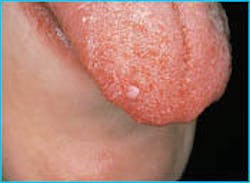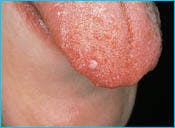Case Study
A 25-year-old female visited a general dentist for an initial examination. During the intraoral exam, a small, white lesion was noted on the dorsal tongue.
History
The patient was aware of the small, frond-like lesion on the tongue and stated that it had been present for at least a couple of months, perhaps longer. The lesion was described as painless and had no history of bleeding. The patient denied any history of trauma to the area.
The patient appeared to be in a general good state of health and denied any history of serious illness. A review of the medical history revealed no significant findings. At the time of the dental appointment, the patient was not taking any medications.
Examination
The patient's blood pressure, pulse rate, and temperature were all found to be within normal limits. No enlarged lymph nodes in the head and neck region were detected upon palpation. Oral examination revealed a small, white lesion with papillary projections on the dorsal tongue (see photo). Palpation of the lesion revealed a well-circumscribed and soft mass. Further examination of the oral tissues revealed no other lesions.
Clinical diagnosis
Based on the clinical information presented, which of the following is the most likely clinical diagnosis?
- condyloma accuminatum
- verruca vulgaris
- squamous papilloma
- giant cell fibroma
- verruciform xanthoma
Diagnosis
- squamous papilloma
Discussion
The squamous papilloma is the most common benign epithelial lesion seen in the oral cavity. It can be described as an exophytic proliferation of stratified squamous epithelium arranged in finger-like projections. Most investigators believe that this lesion is caused by the human papillomavirus (HPV). The route in which the human papillomavirus is transmitted to produce an oral papilloma is uncertain. In contrast to other HPV lesions, this one appears to have a very low virulence and infectivity rate.
Clinical features
Although the papilloma may occur at any age, it most often occurs in adults between the ages of 30 and 50. There is no race or sex predilection. The papilloma is a well-circumscribed, exophytic lesion that appears either white or pink in color. The papilloma may appear pedunculated and exhibit numerous frond-like projections that, when wet, appear to clump together. Or it may appear sessile and exhibit an overall papillary or cauliflower-like surface texture. When palpated, the papilloma is soft. It ranges in size from several millimeters to several centimeters in diameter. The papilloma is asymptomatic; no pain is associated with this lesion.
The papilloma may be found on the vermilion of the lips or any intraoral site. The most common locations include the tongue and soft palate. Other typical locations include the hard palate, gingiva, and buccal mucosa. The papilloma may present as a solitary lesion or occur in multiples.
Diagnosis and treatment
A diagnosis of a papilloma is based on its clinical appearance and characteristic microscopic features. A biopsy and histologic examination are necessary to establish a definitive diagnosis. Other lesions that may be included in the differential diagnosis include the verruca vulgaris and condyloma accuminatum.
The recommended treatment for the papilloma is conservative surgical excision. If the lesion is removed in its entirety, recurrence is unusual.
Joen Iannucci Haring, DDS, MS, is an associate professor of clinical dentistry, Section of Primary Care, The Ohio State University College of Dentistry.

